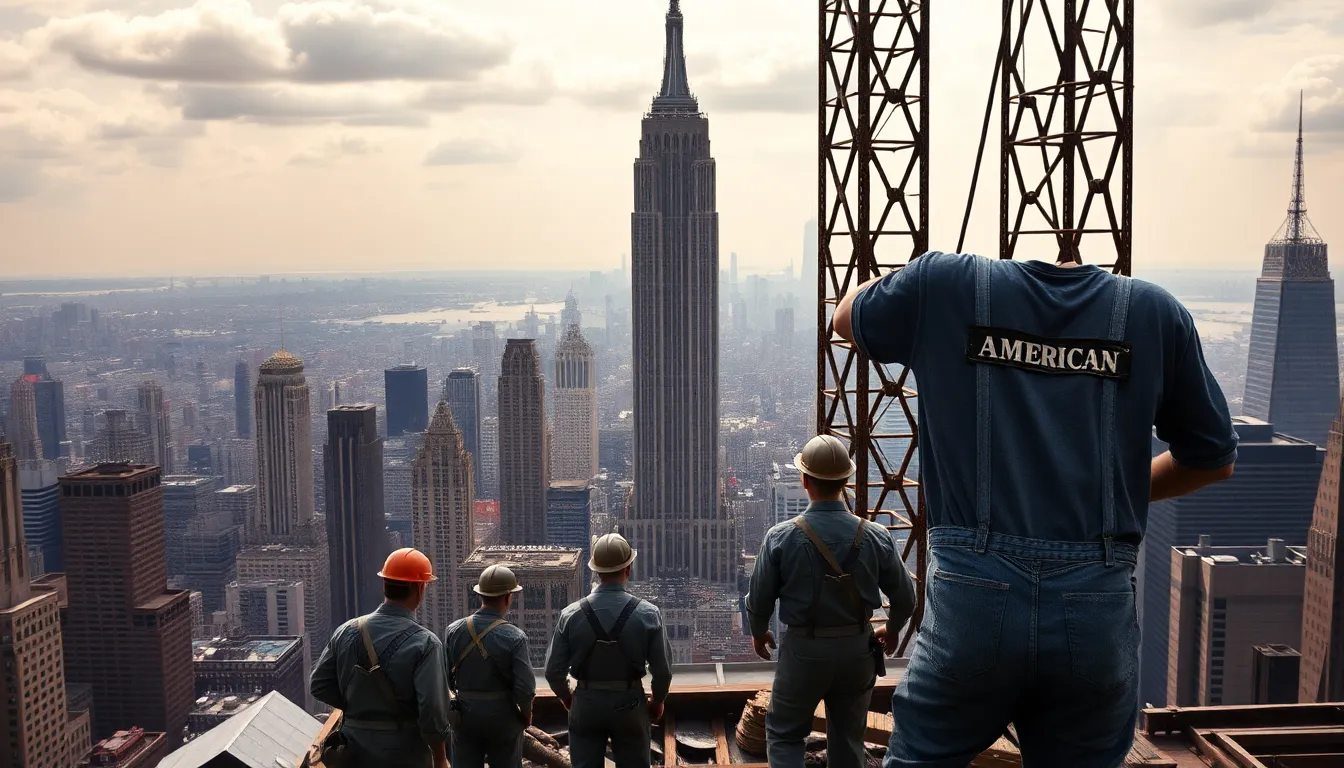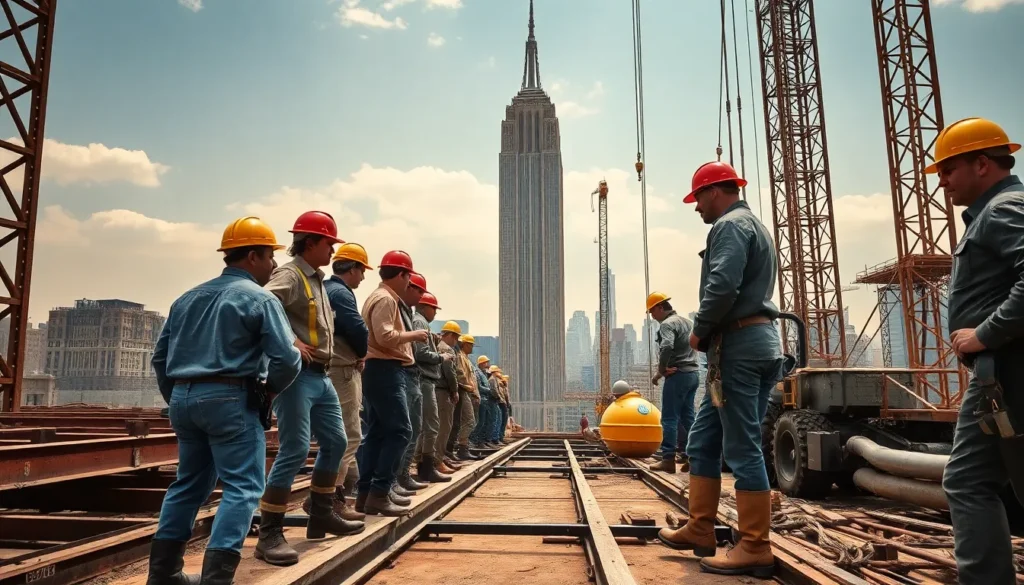Table of Contents
ToggleIn the heart of New York City, a towering marvel stands as a testament to ambition and ingenuity: the Empire State Building. Completed in a record-breaking 13 months during the Great Depression, this architectural giant didn’t just scrape the sky; it redefined what was possible in construction. Imagine a bustling crew of workers, some fueled by coffee and dreams, racing against time to create a landmark that would become synonymous with the Big Apple.
But it wasn’t all hard hats and blueprints. Picture the challenges they faced: unpredictable weather, a world economic crisis, and the occasional pigeon deciding to take a break on a beam. Yet, against all odds, the Empire State Building emerged, reaching for the stars and claiming its place in history. Dive into the fascinating story behind this iconic skyscraper, where determination and creativity built more than just a building—they built a legacy.
Overview of the Empire State Building
The Empire State Building stands at 1,454 feet, making it one of New York City’s tallest skyscrapers. Completed in 1931, it showcases Art Deco architecture, characterized by its sleek lines and ornamental details. Over 3,400 workers collaborated to construct the building in a record 13 months, a remarkable feat during the Great Depression.
Designed by William F. Lamb of Shreve, Lamb & Harmon, the building features 102 stories. Different elements include steel framework, intricate stone carvings, and a distinctive spire that accentuates its height. The construction utilized 60,000 tons of steel, showcasing the engineering prowess of its time.
Located in Midtown Manhattan, the Empire State Building attracts millions of visitors annually. Observation decks on the 86th and 102nd floors provide breathtaking views across the metropolitan skyline. In addition to its aesthetic appeal, the building includes over 2.7 million square feet of office space.
The Empire State Building has maintained its status as an American cultural icon. It symbolizes hope and resilience, overcoming economic challenges to become a beacon of innovation. Additionally, its lighting scheme varies throughout the year, often commemorating holidays and events, further connecting it to New York City’s vibrant culture.
Landmark status ensures its preservation, while ongoing renovations enhance its facilities. As a testament to architectural brilliance, the Empire State Building continues to inspire generation after generation.
Historical Context

The construction of the Empire State Building occurred against a backdrop of significant historical events and fierce competition. Understanding these factors enhances appreciation for its iconic status.
The Great Depression
The Great Depression impacted America profoundly. Unemployment reached 25 percent by 1933, causing widespread financial instability. During this period, construction jobs for the Empire State Building provided employment for thousands. It became a symbol of hope as workers labored under challenging conditions. Innovation in construction techniques allowed the project to progress swiftly, taking only 13 months from groundbreaking to completion. The skyscraper’s creation represented both resilience and ambition, countering the despair surrounding it.
Competition with Other Skyscrapers
Competition among skyscrapers fueled the drive to build the Empire State Building. Architects sought to claim the title of the tallest building in the world. The Chrysler Building, completed in 1930, previously held this title. Originally, the Empire State Building aimed for a height of 1,250 feet, but changes pushed it to 1,454 feet, ensuring supremacy. This rivalry spurred advancements in design and construction, ultimately leading to its Art Deco style. Height became a defining feature in urban landscapes, emphasizing the skyscraper’s place within New York City’s architectural identity.
Design and Architecture
The design and architecture of the Empire State Building exemplify the Art Deco style. This skyscraper features iconic sleek lines and ornamental details that capture the essence of the 1930s architectural movement.
Architectural Style
Art Deco architecture blends modernity with elegance. Influential in the design, bold geometric shapes and decorative motifs define the building’s aesthetic. The façade consists of limestone and granite, providing a grand appearance that matches its towering stature. Vertical lines accentuate its height, guiding the eye skyward. This style represented optimism during the era, connecting the building to the cultural spirit of New York City.
Key Architects and Engineers
William F. Lamb, a prominent architect with Shreve, Lamb and Harmon, led the design efforts. His vision significantly influenced the building’s iconic presence. Engineers collaborated with Lamb, including a team from the firm of Hines and McKenzie, who ensured structural integrity using advanced materials and techniques. The project utilized 60,000 tons of steel, showcasing innovative engineering practices of the time. Together, these professionals contributed to a skyline-defining structure that remains a marvel of modern engineering.
Construction Process
The construction of the Empire State Building unfolded rapidly, showcasing innovative methods and teamwork.
Groundbreaking and Foundation
Groundbreaking occurred on January 22, 1930. The foundation process involved excavating approximately 55,000 cubic yards of rock and soil. Workers completed the foundation within a few months. Concrete and steel played crucial roles in providing stability and support. Significant challenges included the high water table, necessitating the installation of pumps. Many skilled laborers were involved, contributing to the urgent timeline set for completion. This foundational work laid the groundwork for the skyscraper that would soon redefine New York’s skyline.
Materials Used
Building the Empire State Building required an extensive array of materials. Approximately 60,000 tons of steel formed the core structure, providing resilience and strength. Limestone and granite cladding adorned the exterior, enhancing its elegance and durability. Glass and aluminum details contributed to the Art Deco aesthetic. Workers used around 10 million bricks to construct interior walls. Efficient resource management facilitated seamless coordination among suppliers, ensuring timely delivery of materials. Such careful selection and management ensured the building’s lasting impact on the architectural landscape.
Challenges Faced
Numerous challenges arose during the Empire State Building’s construction. Unpredictable weather frequently delayed work, leading to setbacks. Economic constraints imposed by the Great Depression intensified pressure on timelines and budgets. Labor shortages briefly threatened progress, yet engineers found ways to adapt. Safety concerns also emerged, prompting the implementation of strict regulations. Workers navigated these obstacles through innovation and determination. Such perseverance highlighted their commitment to realizing an iconic vision under extraordinary circumstances.
Impact on New York City
The Empire State Building profoundly shaped New York City’s landscape, influencing both its economy and culture.
Economic Influence
Jobs generated by the Empire State Building’s construction provided a vital lifeline during the Great Depression. Thousands of workers, many struggling with unemployment, found employment in a time of dire need. Economic activities surged in the surrounding area, benefiting local businesses and services. The building’s completion also attracted investment, stimulating further commercial development in Manhattan. Generating over 2.7 million square feet of office space, it served as a hub for various industries. Consequently, the iconic structure played a crucial role in revitalizing New York City’s economy.
Cultural Significance
Culturally, the Empire State Building became an enduring symbol of resilience and hope. Visitors often admire its Art Deco design and breathtaking views of the skyline. Each year, millions flock to its observation decks, establishing it as a key tourist attraction. The building frequently lights up in various colors to honor holidays and events, fostering community spirit. Artists, filmmakers, and photographers often draw inspiration from its silhouette, further embedding it in popular culture. As a historic landmark, the Empire State Building embodies New York City’s legacy and ambitious spirit, remaining an integral part of its identity.
The Empire State Building embodies the spirit of resilience and innovation that defines New York City. Its rapid construction during the Great Depression not only provided jobs but also inspired hope for a brighter future. As a cultural icon, it continues to attract millions and serves as a backdrop for countless stories and celebrations.
With its stunning Art Deco design and breathtaking views, the building remains a symbol of architectural excellence. Ongoing preservation efforts ensure that this landmark will inspire generations to come. The Empire State Building is more than just a skyscraper; it’s a testament to human determination and creativity in the face of adversity.







